“This is the second of the sequence, and is an ordinary criss-cross from left half-back to right half-back. If you don’t understand it readily, say so. I want you to ask all the questions you can think of. The halves take positions, as in the preceding play, back of the line behind the tackle-guard holes. The ball goes to left half, who runs just back of quarter. Right half starts a moment after the ball is put in play, also going back of quarter and outside of left half and receiving the ball at a hand pass from the latter, and continuing on through the hole between left end and tackle. Right end starts simultaneously with left half, taking the course indicated, in front of quarter and close to the line, and interfering through the line for the runner.”
[Illustration: 2nd PLAY]
“Left end blocks opposing end outward. Quarter clears the hole out for the runner. Full-back does not start until the pass from quarter to left half is made. He must then time himself so as to protect the second pass. In case of a fumble the ball is his to do the best he can with through the end-tackle hole. If the pass is safe he follows left half through, blocking opposing left end long enough to keep him out of the play.
“You will go through this play to-morrow and you will get your slips to-morrow evening here. Now is there anything not clear to you?”
Apparently there was a great deal, for the questions came fast and furious, the coaches all taking a hand in the discussion, and the diagram being explained all over again very patiently by the head. Then another diagram was tackled.
[Illustration: 3rd PLAY]
“The third of this sequence is from an ordinary formation,” began the head coach. “It is intended to give the idea of a kick, or, failing that, of a run around left end. It will very probably be used as a separate play in the last few minutes of a half, especially where the line-up is near the side line, right being the short side of the field. You will be given the signal calling this as a separate play to-morrow evening.
“Full-back stands as for a kick, and when the signal is given moves in a step or two toward quarter as unnoticeably as possible; position 2 in the diagram. He must be careful to come to a full stop before the ball is snapped back, and should time himself so that he will not have to stay there more than a second. The instant the ball is snapped full-back runs forward to the position indicated here by 3, and receives the ball on a short pass from quarter. Left half starts at the same instant, and receives the ball from full as he passes just behind him, continuing on and around the line outside of right end. It is right half’s play to make the diversion by starting with the ball and going through the line between left tackle and guard; he is expected to get through and into the play on the other side. Left end starts when the ball is snapped, and passing across back of the forwards clears out the hole for the runner. Quarter interferes, assisted by full-back, and should at all costs down opposing half. Right end helps right tackle throw in opposing end. Much of the success of this play depends on the second pass, from full-back to left half, and it must be practiced until there is no possibility of failure. Questions, fellows.”




